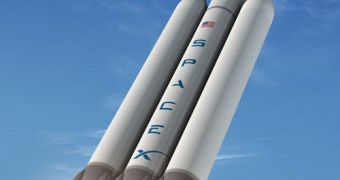The space industry became much more interesting yesterday, following an announcement that a private company would build the largest commercial space rocket yet. The Falcon Heavy will have the most similar capabilities with the Saturn rocket of any other delivery system in existence today.
The announcement was made on Tuesday, April 5, by officials from Hawthorne, California-based Space Exploration Technologies Corporation (SpaceX), the same company that produces the Falcon 1 and Falcon 9 rockets.
Their newest design, called Falcon Heavy, will be the largest private rocket in the world, and will have the ability to carry 53 metric tons (117,000 pounds) of cargo to low-Earth orbit (LEO).
According to SpaceX representatives, the new delivery system will be able to carry three times as much cargo to LEO than existing Falcon 9 boosters. The latter are currently used in combination with the Dragon unmanned space capsule, and are competing for a NASA grant.
During a press conference yesterday, SpaceX CEO and founder Elon Musk told reporters that the new rocket would truly be constructed on a monumental scale. It will be able to carry twice the payload capacity of the space shuttles in a single flight.
Musk added that the only delivery system ever that could carry more cargo than Falcon Heavy was the Saturn 5 rocket, which NASA used for its lunar missions. The last launch of a Saturn 5 took place in 1973. When the SpaceX vehicle is introduced, it will be the heaviest rocket in current operation.
“Falcon Heavy sets a new world record for the cost per pound to orbit. That's a pretty huge leap in capability,” said Musk, quoted by Space. He added that it would cost about $1,000 to launch a pound of cargo in space aboard the new delivery system.
Launching a Falcon Heavy is estimated to cost around $100 million. That's two times more than it currently costs to launch a Falcon 9, but the new rocket can carry three times more payload.
According to Musk, the first of the new rockets could launch as soon as 2013. Each of them will feature a Falcon 9 core delivery system, whose capabilities will be augmented by two additional first stages of the same design.
Each of the three first stages will be powered by 9 Merlin 1D motors, which were developed at SpaceX. The 27 engines will be powered by liquid oxygen (LOX) and rocket-grade kerosene (RP-1) propellants, and will employ a cross-feed system.
This will enable the central core to remain nearly loaded when the entire vehicle reaches orbit. In turn, this contributes to greater overall performances. Falcon Heavy will be able to carry around 19,500 kilograms (43,000 pounds) of cargo to geostationary transfer orbit.
Additionally, Musk explained, it was designed so as to respect human ratings standards, which means that it could one day be used to carry astronauts to orbit. “It can launch people if need be and do so safely,” the SpaceX CEO said.
“It has so much more capability than any other vehicle I think we can start to realistically contemplate missions like a Mars sample return,” he went on to say.
Falcon Heavy will be nearly 70 meters (227 feet) tall, and experts estimate that it will weigh around 1.4 million kilograms, or 3.1 million pounds. The space company designed it so that it could launch from the Vandenberg Air Force Base (VAFB), in California.
Eventually, it could be modified so that it could launch from the Florida-based Cape Canaveral Air Force Station (CCAFS) too.

 14 DAY TRIAL //
14 DAY TRIAL //